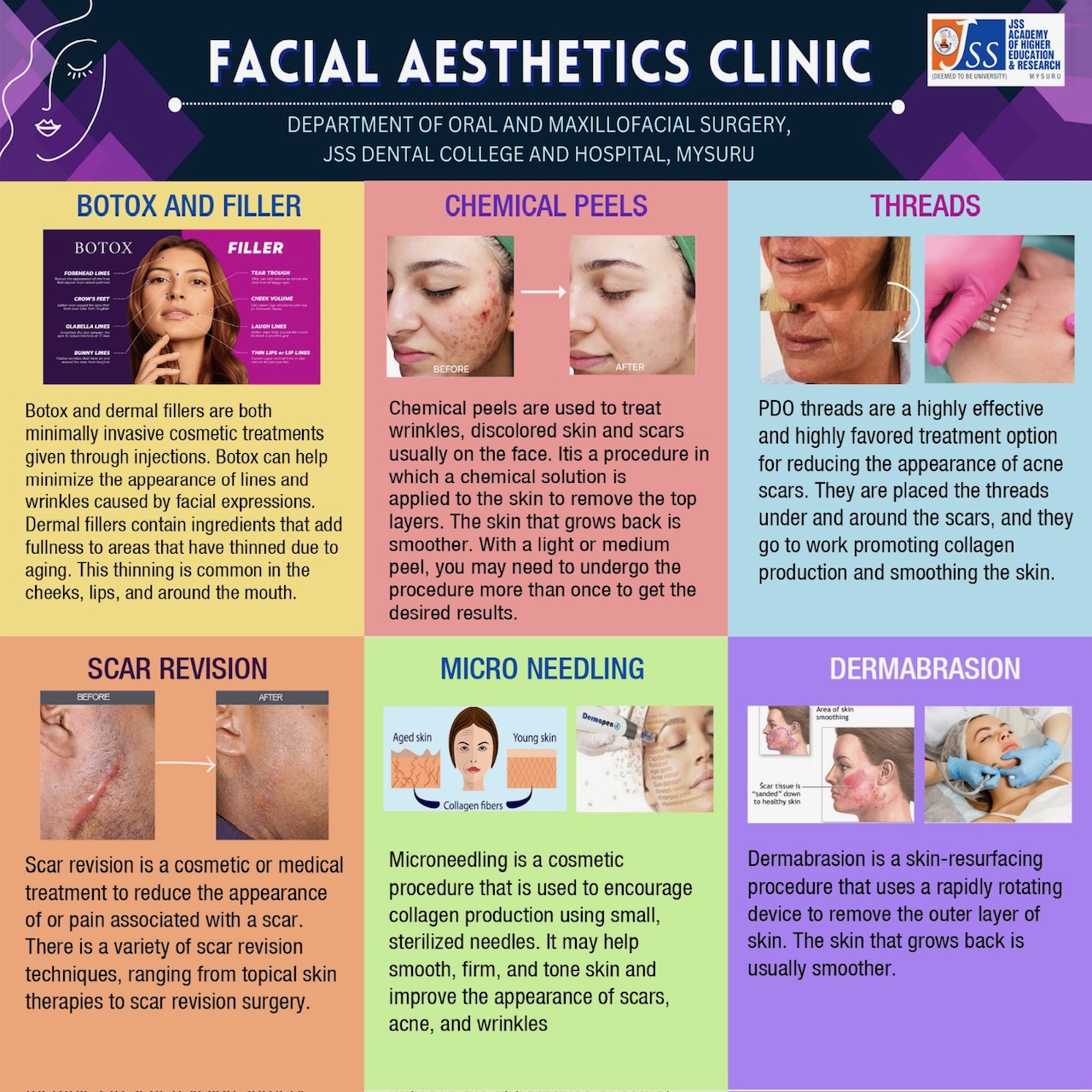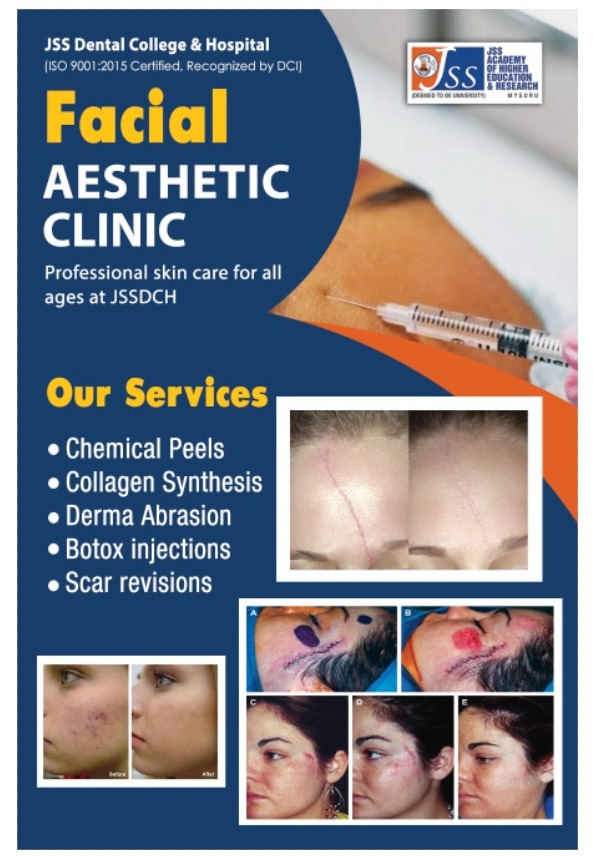

Who Can Enroll
Interns & Post graduate students.
Need / Purpose:
The need and purpose of a facial esthetic course is to provide training and education in the various techniques, procedures, and best practices of facial aesthetics, in order to equip individuals with the knowledge, skills, and competencies needed to safely and effectively perform facial aesthetic treatments.The primary purpose of a facial esthetic course is to provide participants with a comprehensive understanding of the principles, techniques, and safety considerations involved in cosmetic facial treatments. This includes an overview of facial anatomy, knowledge of injectable treatments, chemical peels, microneedling, and other facial rejuvenation techniques, as well as an understanding of the potential risks and side effects associated with these treatments.
Additionally, a facial esthetic course will typically provide instruction on how to perform a facial assessment, treatment planning, consultation skills, patient communication, and ethical and professional practices in facial aesthetics. This training is designed to help participants develop the confidence, knowledge, and skills they need to provide effective and safe facial aesthetic treatments, and to maintain high standards of patient safety and satisfaction.
Overall, the need and purpose of a facial esthetic course is to provide individuals with a comprehensive education in the field of facial aesthetics, so that they can deliver safe and effective treatments, meet the growing demand for cosmetic facial treatments, and advance their careers in this exciting and rapidly growing field.
Expected Outcomes:
The expected outcomes of a facial esthetic course will depend on the specific program or institution, but typically include:
1. Knowledge of facial anatomy and physiology, including the muscles, bones, and soft tissues of the face.
2. Understanding of different facial aesthetic treatments, such as injectable treatments, chemical peels, and microneedling.
3. Ability to identify and assess the different facial aesthetic concerns of clients, such as aging, sun damage, and skin imperfections.
4. Skills in treatment planning, consultation, and patient communication, including the ability to develop a personalized treatment plan that meets the client's needs and expectations.
5. Knowledge of the principles of cosmetic injectable treatments, including product selection, dosing, and injection techniques.
6. Knowledge of the potential risks and side effects associated with facial aesthetic treatments, and the ability to manage these risks effectively.
7. Understanding of the ethical and professional standards that should guide the practice of facial aesthetics, including the importance of informed consent, client confidentiality, and patient safety.
9. Knowledge of the recovery and aftercare processes for facial aesthetic treatments, including recommendations for skincare, sun protection, and follow-up care.
10. Ability to educate clients about facial aesthetic treatments, including their benefits, risks, and outcomes, and to provide appropriate post-treatment care and follow-up.
Learning Objectives of The Course:
The learning objectives of a facial esthetics course will depend on the specific program or institution, but typically include:
1. Understanding of facial anatomy and physiology, including the muscles, bones, and soft tissues of the face.
2. Knowledge of the different facial aesthetic treatments, including injectable treatments, chemical peels, and microneedling.
3. Ability to identify and assess facial aesthetic concerns, such as aging, sun damage, and skin imperfections.
4. Skills in treatment planning, consultation, and patient communication, including the ability to develop a personalized treatment plan that meets the client's needs and expectations.
5. Knowledge of the principles of cosmetic injectable treatments, including product selection, dosing, and injection techniques.
6. Knowledge of the potential risks and side effects associated with facial aesthetic treatments, and the ability to manage these risks effectively.
7. Understanding of the ethical and professional standards that should guide the practice of facial aesthetics, including the importance of informed consent, client confidentiality, and patient safety.
8. Ability to perform facial aesthetic treatments, such as injections, chemical peels, and microneedling, in a safe and effective manner, using proper techniques and protocols.
9. Knowledge of the recovery and aftercare processes for facial aesthetic treatments, including recommendations for skincare, sun protection, and follow-up care.
10. Ability to educate clients about facial aesthetic treatments, including their benefits, risks, and outcomes, and to provide appropriate post-treatment care and follow-up.
11. Understanding of the latest research, techniques, and developments in the field of facial aesthetics, and the ability to apply this knowledge to their practice.
12. Knowledge of the regulations, policies, and standards that govern the practice of facial aesthetics, including an understanding of the role of professional organizations, licensing boards, and other governing bodies.
Content And Syllabus:
A value-added course on facial aesthetics will cover various topics related to improving the appearance of the face through cosmetic procedures and treatments. The course may include:
1. Anatomy and physiology of the face
2. Overview of facial aesthetic treatments such as dermal fillers, Botox, chemical peels, microneedling, etc.
3. Assessment of facial symmetry and proportions
4. Techniques for facial rejuvenation and contouring
5. Treatment planning and consultation skills
6. Injection techniques for facial aesthetic treatments
7. Safety and potential risks associated with facial aesthetic procedures
8. Ethics and professionalism in facial aesthetics
Teaching And Learning Activities:
The teaching and learning activities in a facial esthetics course may include a variety of different methods and approaches, including:1. Lectures and discussions: Participants will receive instruction through a combination of lectures, discussions, and interactive learning activities that cover the fundamentals of facial anatomy, cosmetic injectable treatments, chemical peels, and microneedling, among other topics.
2. Hands-on practice: Participants will engage in hands-on learning activities that provide an opportunity to practice and master the techniques of cosmetic injectable treatments, chemical peels, and microneedling. This may include supervised practice on live models, or on specially designed training aids.
3. Video demonstrations: Participants may be provided with video demonstrations of various facial esthetic procedures, to help illustrate key concepts and techniques.
4. Case studies and role-playing: Participants may engage in case studies and role-playing activities that help develop their skills in treatment planning, consultation, and patient communication
5. Online learning: Some facial esthetics courses may include online components, such as interactive quizzes, virtual tutorials, and other interactive learning tools.
6. Exams and assessments: Participants may be evaluated through a combination of written and practical exams, as well as regular assessments of their progress throughout the course.
7. Workshops and hands-on training sessions: Some courses may include workshops and hands-on training sessions with experienced practitioners, who will provide additional guidance and feedback on the participants' skills and technique.
8. Group projects and assignments: Participants may engage in group projects and assignments that help develop their skills in areas such as patient assessment, treatment planning, and professional communication.
Resources:
There are several resources that may be useful in a facial esthetics course, including:1. Textbooks: Participants will likely be provided with a recommended textbook that covers the fundamentals of facial anatomy, cosmetic injectable treatments, chemical peels, microneedling, and other topics.
2. Online resources: Participants may have access to online resources, such as websites, videos, and interactive tutorials that provide additional information and support for the course content.
3. Medical journals and professional associations: Participants may be encouraged to read relevant medical journals and to join professional organizations that focus on facial aesthetics.
4. Experienced instructors and trainers: Participants will benefit from the guidance and support of experienced instructors and trainers, who will provide hands-on instruction and feedback on the participants' skills and technique.
5. Clinical settings and training facilities: Participants may have the opportunity to engage in supervised hands-on learning activities in clinical settings and training facilities, where they can observe and practice various facial esthetic procedures.
6. Patient interactions: Participants may have the opportunity to interact with patients in a supervised setting, to gain experience in areas such as patient assessment, treatment planning, and professional communication.
Assessment Method:
1. Written exams: Participants will be required to complete written exams to test their knowledge and understanding of course content, including anatomy, injectable treatments, chemical peels, microneedling, and other topics.2. Practical assessments: Participants will be assessed through practical assessments, where they demonstrate their skills and techniques in performing facial esthetic procedures in a supervised setting.
3. Case studies: Participants will be required to complete case studies, where they apply their knowledge and skills to real-life scenarios and provide treatment recommendations. Direct observation: Participants may be assessed through direct observation, where they are observed performing procedures on patients in a clinical setting and receive feedback from the instructor or trainer.
Schedule:
Reading resources: 8hrsHands on workshop: 6hrs
Day 1: 3 hrs
• Introduction to facial anatomy and physiology – 1 hour
• Overview of facial aesthetics and the role of injectable treatments – 1 hour
• Product selection and dosing principles – 1 hour
Day 2: 3 hrs
• Injection techniques for various facial areas (forehead, eyes, nose, lips, cheeks, etc.) – 1 hour
• Hands-on injection practice using models or simulated materials – 2hrs
Day 3: 3 hrs
• Review of injection techniques and product selection – 1hr
• Discussion of potential risks and side effects – 1hr
• Informed consent and patient selection – 1hr
Day 4: 3 hrs
• Chemical peels: Types, indications, and procedures – 1hr
• Hands-on practice with chemical peels – 2hr
Day 5: 3hrs
• Microneedling: Principles and techniques – 1hr
• Hands-on practice with microneedling devices – 2hrs
Day 6: 2hrs
• Treatment planning and consultation skills – 1hr
• Ethics and professionalism in facial aesthetics – 1hr
Review of course content and evaluation – 2hrs